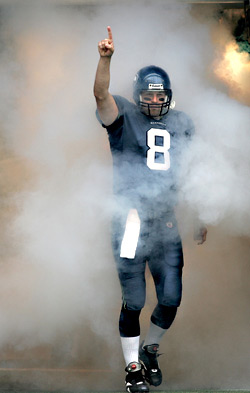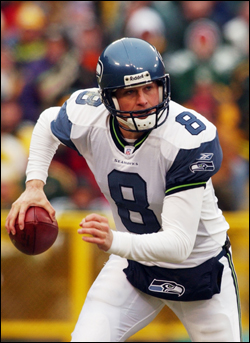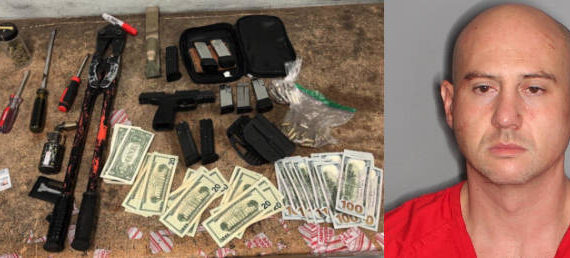The final score of Super Bowl XL — Pittsburgh 21, Seattle 10 — will remain etched in the collective mind of local fandom for eternity, pending the inevitable Tim Eyman-led referendum to overturn the outcome. If that were to happen, it’s still likely the game refs would find a reason to give it back to Pittsburgh. The officials handed it to the Steelers on nearly every occasion, especially when the game was on the line in the fourth quarter, with Pittsburgh ahead 14-10 and the Hawks threatening to take the lead. Twice in a row it appeared on TV as though the Steelers’ left defensive end was off sides, but the call wasn’t made. A few minutes later the Steelers scored again and the game was basically over.
Seattle fans vented ref-rage on radio call-in programs. Then the backers of other National Football League teams had their say. Minutes after the game ended in Detroit on Sunday, Feb. 5, somebody posted on an ESPN Nation message board. Part of it: “If you’re not a Steelers fan, there are major concerns about the legitimacy of the game.” Another: “I’m a Rams fan and I hate the Hawks and they were cheated on 2 TDs.” Yet another: “Green Bay fan. I didn’t even really want the Seahawks, but this was just bad. And I thought boxing was fixed.” Page after page, Broncos, Bears, Giants, Redskins, Raiders, and other fans vehemently agreed, not that any of it matters.
The Hawks clearly made more mistakes than they had during previous playoff games. Jerramy Stevens dropped catchable balls. Josh Brown missed a pair of field goals he usually makes. Even with less-unfavorable officiating, Seattle might have lost. The Seahawk season consumed the local population, especially during the playoff weeks. But some believe Super Bowl XL was a game nearly preordained to wind up a Pittsburgh win. Media attention seemed overwhelmingly pro-Steelers, and the betting line opened and closed with Pittsburgh favored.
The Hawks clearly made more mistakes than they had during previous playoff games. Jerramy Stevens dropped catchable balls. Josh Brown missed a pair of field goals he usually makes. Even with less-unfavorable officiating, Seattle might have lost.
The Hawks won the opening toss and played great ball-control offense for the first quarter, when the Steelers didn’t get a first down during three possessions and Seattle led 3-0. Pittsburgh was in front 7-3 at halftime after Steelers quarterback Ben Roethlisberger sneaked within a millimeter of the goal-line plane on a play the referees reviewed. Blown coverage in the Seattle secondary gave Pittsburgh a 14-3 third-quarter lead when Willie Parker set a Super Bowl record with his 75-yard gallop, untouched, for a score. The Hawks seemed ready for a comeback halfway through the third quarter, when Kelly Herndon intercepted a Roethlisberger pass and scampered 75 yards to set up a Matt Hasselbeck-to-Stevens touchdown pass. A Steelers gimmick play made it 21-10 with 9:04 to play. Seattle’s final possessions ended in futility. When it was over, the Steelers had won an impressive seven straight games, the most recent four on the road. Receiver Hines Ward won the Most Valuable Player award and Bill Cowher finally had coached a world champ.
After the game, a stunned Hasselbeck came within syllables of citing bad calls. Equally subdued was owner Paul Allen, who said that “you’ve gotta take that pain and use it for motivation for next year.”
Fans were still seething about the end to this season. After all, even those who didn’t go to Detroit had invested plenty. A typical game-day observation in a region where a weekend storm brought power outages was of Hawk-lovers lining up just to get into saloons to watch the game. The Village Pub in Magnolia, christened the city’s best sports bar after a weeks-long Seattle Post-Intelligencer competition, had customers lined up two hours prior to the 9 a.m. Sunday opening.
Leading up to Super Bowl XL were two weeks of fewer hard-news leads out of Detroit, Seattle, and Pittsburgh than you’d expect from the average Amway convention. Some among the myriad commentators couldn’t seem to pronounce Pittsburgh safety Troy Polamalu’s last name the same way twice. Among the story-starved scribes covering the game, much was made starting Tuesday, Jan. 31, about mild remarks from Hawk tight end Stevens. The recovering ne’er-do-well of Husky and Hawk grid notoriety prompted the ire of the Steelers’ Joey Porter, leading to three days of some of the most ill-articulated playground talk since second-grade recess. Officials at Texas A&M actually took legal aim at the Hawks using “12th Man” to describe fans.
When the media-week silly stuff went away, all that mattered was whether the Seahawks would bring a feasible game plan and focused players to make it work. It’s what coach Mike Holmgren and company had been doing virtually every week since mid-September. Holmgren, nearly hounded into a self-motivated departure after the disappointing end of the 2004-’05 season, found himself within points of becoming the only mentor to have won Super Bowls with more than one team. The Seahawks, with a stable roster, are expected to be a top-echelon NFL competitor for the next few seasons. Barring injury and/or poor draft selections, the Hawks — even if they don’t sign Shaun Alexander to a new contract — should have the talent and continuity to at least win their weak division for the foreseeable future.
Losing a Super Bowl scarcely makes the season a failure. The Hawks are to be admired for going well beyond just about anybody’s expectations. Holmgren, who seemed much more patient during his seventh year here, earns part of the credit. But many have observed how the stewardship of Tim Ruskell, the new president of football operations, placed a premium on character and smarts; skill was relegated to third-place consideration. It meant jettisoning talented “bad locker-room guys” such as Anthony Simmons and Chike Okeafor in favor of pitch-in players drifting on the periphery of the league. Exhibit A was Marquand Manuel, scarcely a me-first type having been born to a family of 18 kids. He was brought in after the Pioneer Square altercation that left safety Ken Hamlin severely injured. Manuel helped shore up a secondary aptly labeled because it included a procession of over-achieving second-tier players. Even the defensive coordinator, John Marshall, was a fill-in after nominal dee-coach Ray Rhodes suffered a stroke. The defense itself was fill-in, with eight new starters in 2005 and only one, Grant Wistrom, playing the same position he did in 2004.
But the 30th version of the Seahawks also had a corps of stars to match many of the past NFL world champions. Seven Hawks were to appear in the Feb. 12 Pro Bowl. Hasselbeck emerged as the commanding field leader many expected. Rookie Lofa Tatupu, with limited expectations among fans and even coaches, belied his relatively slight size and lack of experience to become a remarkable middle linebacker and team leader. Alexander: merely the league’s most valuable player.
Good football, many agree, begins at the offensive line, which protects the quarterback and helps maintain possession time. Walter Jones is the consensus-best left tackle in the league; next to him are Pro Bowlers Steve Hutchinson at left guard and Robbie Tobeck at center. It’s such a formidable trio that some experts don’t even bother to mention the excellent play of the right-side guard-tackle tandem of Chris Gray and Sean Locklear. Superb offensive-line play in front of a talented quarterback and a best-in-class running back means an offense would be potent even with mediocre receivers. But Seattle’s pass-catchers were at the high end of the NFL curve, with far fewer dropped balls than plagued the team during other recent years. Even with star wide-out Darrell Jackson missing the middle of the season, perennial third-down demon Bobby Engram found ways to get open to keep drives alive. Joe Jurevicius, another Ruskell find, was an indispensable component; tight-end Stevens finally fulfilled the promise of his exceptional talent.
The season will be remembered for other milestones. The Hawks had been one of few franchises never to win a championship game. Its futility was best personified by the team’s most durable cog, Mack Strong. The 12-year-veteran fullback, now a Pro Bowl starter, finally got the credit due for a career mostly spent with a struggling franchise that was moved to Anaheim (and back) by sad-sack former owner Ken Behring. Strong’s commitment to winning had more than a little to do with the Seahawks finding ways to triumph in games they might easily have lost earlier years. That enviable season’s record, 15-4, could have been a lot worse had Strong and other team leaders not made it clear that it was time for the franchise to move to the front of the league.
Certain fans will be fixed on the 21-10 ending of the season. Others will look forward. Some among the hordes who spent thousands to actually attend justified the money by describing the Super Bowl as a “once-in-a-lifetime opportunity.” Twelve (assuming Texas A&M officials will permit use of the number) months from now, there’s another S.B. to be played. It’s in Miami. Good advice might be to book airfare and accommodations earlier this time.








